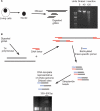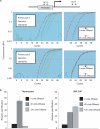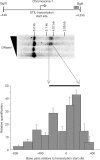Real-time PCR mapping of DNaseI-hypersensitive sites using a novel ligation-mediated amplification technique
- PMID: 17389645
- PMCID: PMC1885650
- DOI: 10.1093/nar/gkm108
Real-time PCR mapping of DNaseI-hypersensitive sites using a novel ligation-mediated amplification technique
Abstract
Mapping sites within the genome that are hypersensitive to digestion with DNaseI is an important method for identifying DNA elements that regulate transcription. The standard approach to locating these DNaseI-hypersensitive sites (DHSs) has been to use Southern blotting techniques, although we, and others, have recently published alternative methods using a range of technologies including high-throughput sequencing and genomic array tiling paths. In this article, we describe a novel protocol to use real-time PCR to map DHS. Advantages of the technique reported here include the small cell numbers required for each analysis, rapid, relatively low-cost experiments with minimal need for specialist equipment. Presented examples include comparative DHS mapping of known TAL1/SCL regulatory elements between human embryonic stem cells and K562 cells.
Figures




Similar articles
-
Rapid high-throughput analysis of DNaseI hypersensitive sites using a modified Multiplex Ligation-dependent Probe Amplification approach.BMC Genomics. 2009 Sep 4;10:412. doi: 10.1186/1471-2164-10-412. BMC Genomics. 2009. PMID: 19728890 Free PMC article.
-
Identifying gene regulatory elements by genomic microarray mapping of DNaseI hypersensitive sites.Genome Res. 2006 Oct;16(10):1310-9. doi: 10.1101/gr.5373606. Epub 2006 Sep 8. Genome Res. 2006. PMID: 16963707 Free PMC article.
-
Mapping regulatory elements by DNaseI hypersensitivity chip (DNase-Chip).Methods Mol Biol. 2009;556:177-90. doi: 10.1007/978-1-60327-192-9_13. Methods Mol Biol. 2009. PMID: 19488879
-
Genome-wide mapping of DNase I hypersensitive sites in plants.Methods Mol Biol. 2015;1284:71-89. doi: 10.1007/978-1-4939-2444-8_4. Methods Mol Biol. 2015. PMID: 25757768
-
Identification of DNaseI hypersensitive sites within nuclei.Methods Mol Biol. 2000;130:29-46. doi: 10.1385/1-59259-686-x:29. Methods Mol Biol. 2000. PMID: 10589419 Review. No abstract available.
Cited by
-
Sequence composition similarities with the 7SL RNA are highly predictive of functional genomic features.Nucleic Acids Res. 2010 Aug;38(15):4907-16. doi: 10.1093/nar/gkq234. Epub 2010 Apr 14. Nucleic Acids Res. 2010. PMID: 20392819 Free PMC article.
-
Rapid high-throughput analysis of DNaseI hypersensitive sites using a modified Multiplex Ligation-dependent Probe Amplification approach.BMC Genomics. 2009 Sep 4;10:412. doi: 10.1186/1471-2164-10-412. BMC Genomics. 2009. PMID: 19728890 Free PMC article.
-
A novel mode of enhancer evolution: the Tal1 stem cell enhancer recruited a MIR element to specifically boost its activity.Genome Res. 2008 Sep;18(9):1422-32. doi: 10.1101/gr.077008.108. Epub 2008 Aug 7. Genome Res. 2008. PMID: 18687876 Free PMC article.
-
Endoglin expression in blood and endothelium is differentially regulated by modular assembly of the Ets/Gata hemangioblast code.Blood. 2008 Dec 1;112(12):4512-22. doi: 10.1182/blood-2008-05-157560. Epub 2008 Sep 19. Blood. 2008. PMID: 18805961 Free PMC article.
-
Fine scale mapping of the breast cancer 16q12 locus.Hum Mol Genet. 2010 Jun 15;19(12):2507-15. doi: 10.1093/hmg/ddq122. Epub 2010 Mar 23. Hum Mol Genet. 2010. PMID: 20332101 Free PMC article.
References
-
- Vyas P, Vickers MA, Simmons DL, Ayyub H, Craddock CF, Higgs DR. Cis-acting sequences regulating expression of the human alpha-globin cluster lie within constitutively open chromatin. Cell. 1992;69:781–793. - PubMed
-
- Sawada S, Scarborough JD, Killeen N, Littman DR. A lineage-specific transcriptional silencer regulates CD4 gene expression during T lymphocyte development. Cell. 1994;77:917–929. - PubMed
-
- Ansel KM, Greenwald RJ, Agarwal S, Bassing CH, Monticelli S, Interlandi J, Djuretic IM, Lee DU, Sharpe AH, et al. Deletion of a conserved Il4 silencer impairs T helper type 1-mediated immunity. Nat. Immunol. 2004;5:1251–1259. - PubMed
Publication types
MeSH terms
Substances
Grants and funding
LinkOut - more resources
Full Text Sources
Research Materials
Miscellaneous

